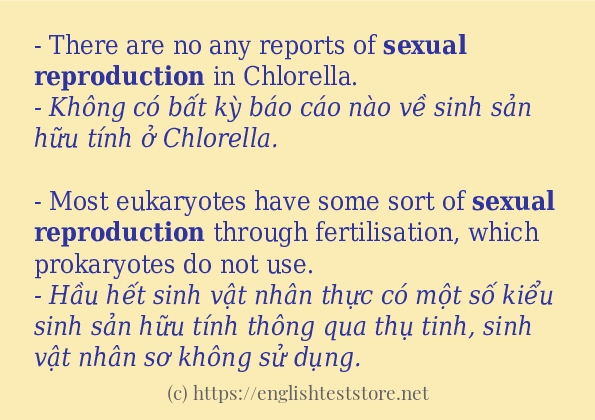Các cách sử dụng từ “sexual reproduction”:
– There are no any reports of sexual reproduction in Chlorella.
– Không có bất kỳ báo cáo nào về sinh sản hữu tính ở Chlorella.
– Most eukaryotes have some sort of sexual reproduction through fertilisation, which prokaryotes do not use.
– Hầu hết sinh vật nhân thực có một số kiểu sinh sản hữu tính thông qua thụ tinh, sinh vật nhân sơ không sử dụng.
– In botany, apomixis was defined by Hans Winkler as the replacement of the normal sexual reproduction by asexual reproduction, without fertilization.
– Trong thực vật học, apomixis được Hans Winkler định nghĩa là sự thay thế sinh sản hữu tính bình thường bằng sinh sản vô tính, không cần thụ tinh.
– Ovules produce the female reproductive Cell cells which get fertilized during sexual reproduction in seed plants.
– Noãn tạo ra các tế bào Tế bào sinh sản cái được thụ tinh trong quá trình sinh sản hữu tính ở cây có hạt.
– The fruit is part of a plant’s sexual reproduction cycle.
– Quả là một phần của chu kỳ sinh sản hữu tính của thực vật.

Các câu ví dụ cách dùng từ “sexual reproduction”:
– But sexual reproduction is very common in simpler forms of life, where the males have nothing to do with their offspring.
– Nhưng sinh sản hữu tính rất phổ biến ở các dạng sống đơn giản hơn, nơi con đực không liên quan gì đến con cái của chúng.
– In sexual reproduction its hyphae touch the hyphae of another “Rhizopus” mycelium.
– Trong sinh sản hữu tính, sợi nấm của nó chạm vào sợi nấm của một sợi nấm “Rhizopus” khác.
– Most eukaryotes use sexual reproduction to make new copies of themselves.
– Hầu hết các sinh vật nhân thực sử dụng sinh sản hữu tính để tạo ra các bản sao mới của chính mình.
– Five of the 21 species of “Timema” are parthenogenetic, including two species that have done sexual reproduction for a million years.
– Năm trong số 21 loài “Timema” là di truyền gen, bao gồm hai loài đã thực hiện sinh sản hữu tính trong một triệu năm.
– The sex organs or genitals are used for sexual reproduction and for sexual intercourse.
– The sex organs or genitals are used for sexual reproduction and for sexual intercourse.
– Pollination is part of sexual reproduction in plants.
– Thụ phấn là một phần của quá trình sinh sản hữu tính ở thực vật.
– Eukaryotes bother with the more complicated process of meiosis because sexual reproduction such as meiosis confers a selective advantage.
– Sinh vật nhân chuẩn bận tâm với quá trình meiosis phức tạp hơn bởi vì sinh sản hữu tính như meiosis mang lại lợi thế chọn lọc.
– The sexual reproduction produces resting eggs that allow the species to survive harsh conditions and disperse to distant habitats.
– The sexual reproduction produces resting eggs that allow the species to survive harsh conditions and disperse to distant habitats.
– Thus, sexual reproduction appears to be highly inefficient.
– Do đó, sinh sản hữu tính dường như không hiệu quả cao.
– Both Asexual reproductionasexual and sexual reproduction occur.
– Cả sinh sản vô tính và sinh sản hữu tính đều xảy ra.
– In sexual reproduction there is, from the point of view of evolution, a fundamental difference of interest between males and females.
– Theo quan điểm của tiến hóa, trong sinh sản hữu tính, có sự khác biệt cơ bản về lợi ích giữa con đực và con cái.
– Two animals coming together for the purposes of sexual reproduction is called mating.
– Hai động vật đến với nhau vì mục đích sinh sản hữu tính được gọi là giao phối.
– In sexual reproduction the cells used for reproduction, called gametes, are either eggs or sperms.
– Trong sinh sản hữu tính, các tế bào được sử dụng để sinh sản, được gọi là giao tử, là trứng hoặc tinh trùng.
– The Titan Stick insect reproduces through sexual reproduction and lay eggs that hatch.
– Côn trùng Titan Stick sinh sản thông qua sinh sản hữu tính và đẻ trứng nở.
- But sexual reproduction is very common in simpler forms of life, where the males have nothing to do with their offspring. - Nhưng sinh sản hữu tính rất phổ biến ở các dạng sống đơn giản hơn, nơi con đực không liên quan gì đến con cái của chúng.
- In sexual reproduction its hyphae touch the hyphae of another "Rhizopus" mycelium. - Trong sinh sản hữu tính, sợi nấm của nó chạm vào sợi nấm của một sợi nấm "Rhizopus" khác.
- In sexual reproduction its hyphae touch the hyphae of another "Rhizopus" mycelium. - Trong sinh sản hữu tính, sợi nấm của nó chạm vào sợi nấm của một sợi nấm "Rhizopus" khác.
